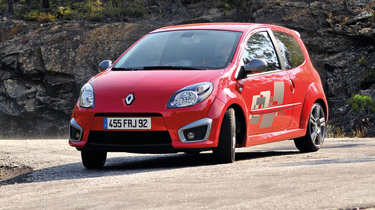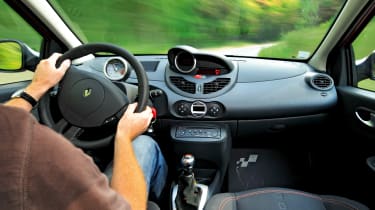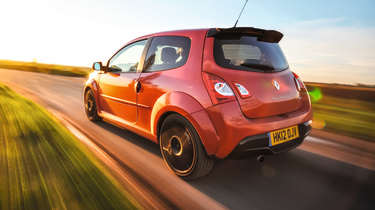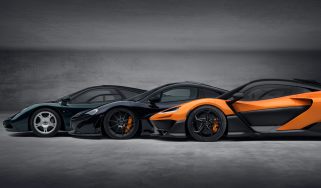Renault Sport Twingo 133 (2008 - 2013) review: big fun, small price
The Twingo 133 was launched as the entry-level RS option, packing a truly entertaining driving experience into a modest package
Read through the spec sheet of the Twingo 133 and you might wonder if it’s deserving of the Renault Sport moniker at all. Its 1.6-litre four-pot generates a modest 131bhp and 118lb ft of torque, it covers 0-62mph in a leisurely 8.7 seconds and there are no fancy dampers or extensive weight-saving measures. Instead, however, the 133 is an example of how expert engineering can turn a basic supermini into a highly entertaining, affordable driver’s car that is permeated with true Renault Sport DNA.
The 133 was launched as the entry point to the Renault Sport line-up in 2008, designed to attract younger buyers who would subsequently trade up to a Clio 197 or Mégane RS. It cost just £11,550 (around £18k in today’s money) and packed a host of upgrades designed to make it steer, stop and go like a true hot hatch, as well as look like one. At the front you’ll notice a larger intake to feed more cooling air to the engine, and the 133’s wheels are pushed out beyond the Twingo’s regular bodywork thanks to widened tracks (by 60mm and 59mm front and rear respectively), necessitating some chunky wheelarch extensions.
> Renault Sport Clio 200 Turbo – the car world's greatest misses
More reviews
Reviews
- Renault Sport Twingo 133 (2008 - 2013) review: big fun, small price
- Renault Twingo GT review
- Renault Twingo Dynamique TCe review and pictures
- Renault Twizy electric car review
- Renault Twizy electric car review
- Renault Twingo Bizu new car review
- Renaultsport Twingo Gordini 133 review
- Renault Twingo Gordini review
To instil the Twingo with the kind of sharpness and agility of its larger siblings, Renault Sport fitted a stiffer rear anti-roll bar to improve turn-in, and the 133 sits 10mm lower on stiffer springs than the Twingo GT, with revised dampers to suit. Customers had the option to go a step further with a £650 Cup chassis option, which drops the ride height by a further 4mm and brings a 10 per cent increase in spring rate, as well as larger, 17-inch alloys. Unless you plan on using your Twingo on track, we’d suggest looking for a car with the standard chassis – the extra compliance is welcome on the kind of tight, ragged B-roads that suit the Twingo.
For outright thrills you’ll be better off in a Clio 172 or 182, but the Twingo has the kind of willing, eager personality that makes hot superminis so appealing. Driving it is a lesson in conserving momentum, leaning on the grip from the generously wide 195-section tyres and timing your gearchanges to keep the engine hovering near the 7000rpm red line. It’s not a car that constantly feeds you information, but the Twingo’s responses are consistent and it gives you confidence to flick it into corners and through direction changes in classic hot hatch style.
What to pay
The 133 wasn’t quite the sales hit that Renault was hoping for, meaning that there are far fewer used examples on the market than there are hot Clios. Still, there are plenty of pre-facelift cars (as pictured) to be found dipping below the £4000 mark, with the best low-mileage ones commanding up to £5k. Facelifted models (from 2012/13) are available around £5k too, but given that the changes were largely cosmetic we’d be just as happy opting for the original.
What to look out for
The 1.6-litre engine is reliable if the maintenance schedule has been followed (a service is needed every year or 12,000 miles, with a cambelt change at 72,000), but suspension components are prone to wear – particularly the lower-arm ball joints, which require a new front suspension arm to replace them. It’s not hugely expensive, £250 all-in, but it’s a regular issue, so keep an ear out for clunks or knocks on the test drive.
Make sure the engine idles smoothly and revs cleanly, as you’ll need to charge for the red line to extract all the performance according to Mike, ‘You really have to rev the nuts off it’. If it’s not revving freely, the culprit is likely to be a knackered coil pack that needs replacing – an inexpensive fix.
Boot-releases are known to fail with water ingress being the typical cause, but they’re cheap to change. Check the footwells for dampness too, water can bypass the scuttle panel finding its way inside. It goes without saying but test all the electronics work too, including the air con. The Twingo is better here compared to other Renaults, but the LCD displays can fade and new units cost hundreds. That aside, a 133 is unlikely to throw up expensive mechanical issues and should be happy buzzing at 7000rpm for many miles to come.
What we said
Push hard and you will find understeer, but the way the Twingo changes direction with so little fuss means you don’t often breach the slip barrier. The ESP stability program is well judged, too. I don’t find myself searching for the off switch for ages...
Get the orange button glowing, pin the throttle and the Twingo is with you every step of the way. There’s a hunger for corners that’s invigorating – even if the steady trickle of information is fed back to you through the chassis rather than the steering. Electric steering is to blame, robbing the Twingo of true clarity. At least the helm is accurately and consistently weighted with a pleasingly quick rack – half a turn of lock deals with most corners.
The brakes are meaty underfoot – developed for the Mégane, they’re reassuringly positive – and when the rev needle homes in on 7000rpm (and the tuneful 1.6 begins to sound just a touch ragged) the change-up light glows green. That’s green for go, grab another gear, give it some. It’s a small thing, but it matters somehow. – evo 123, September 2008
Without the Cup chassis, the 133 has a nicely judged suspension set-up for a modern junior hot hatch. It feels sporty, generates plenty of grip and allows you to make the most of the modest performance on offer. The Cup chassis tightens things up another notch. It’s perfect for trackdays, but on the road you’ll find yourself pogo-ing in your seat along bumpier tarmac; it can even be a limiting factor on particularly poor surfaces. It’s bearable for the driver (just), but your passengers will complain. A lot. The payback, however, is fabulously instant and accurate responses to your steering inputs. On both set-ups the Renault Twingo 133’s light 1050kg kerb weight is obvious, helping the brakes feel strong (despite looking tiny), and ensuring brisk acceleration (0-62mph takes 8.7sec). The shift action from fourth to fifth is a bit obstructive, though – we’ve experienced this on two different cars, suggesting it’s normal.
The K-Tec Twingo feels quicker than standard but not by the advertised 32bhp and it certainly never has the bite of a Clio despite what the power-to-weight ratio says. The more aggressive camshaft also brings a pronounced flatspot from 2300-2800rpm or so, which is a bit of a pain in everyday driving.
Admittedly, as the engine doesn’t really get going until after 3000rpm it’s less of an issue when you’re enjoying a quiet road and from about 4500rpm it definitely pulls harder than the standard car. Apart from that the inherent Twingo qualities shine through – sweet steering, good traction, adjustable balance, slight instability on the brakes (and too much ABS intervention) and a lumpy, physical ride. Added to one of the bargain, £5000 used Twingos on the market, it looks like an enjoyable upgrade.
Renault Sport Twingo 133 specs
| Engine | In-line 4-cyl, 1598cc |
| Max power | 131bhp @ 6750rpm |
| Max torque | 118lb ft @ 4400rpm |
| 0-62mph | 8.7sec |
| Weight | 1050kg |
| Power-to-weight | 127bhp/ton |
| Top speed | 125mph |
| Price new | £11,550 |
| Value today | From £3500 |






